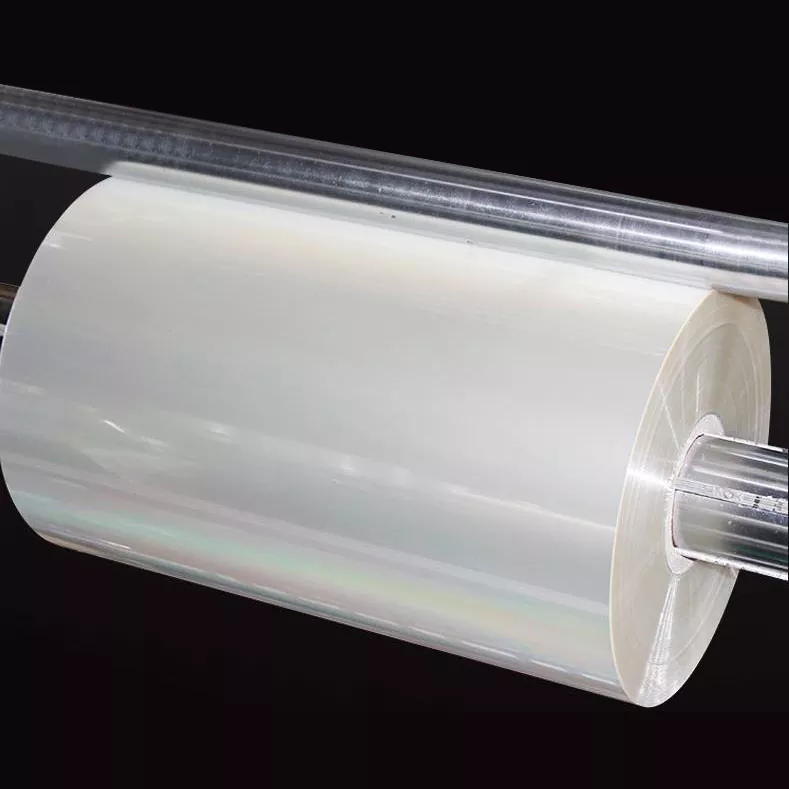
- English
- Español
- Português
- русский
- Français
- 日本語
- Deutsch
- tiếng Việt
- Italiano
- Nederlands
- ภาษาไทย
- Polski
- 한국어
- Svenska
- magyar
- Malay
- বাংলা ভাষার
- Dansk
- Suomi
- हिन्दी
- Pilipino
- Türkçe
- Gaeilge
- العربية
- Indonesia
- Norsk
- تمل
- český
- ελληνικά
- український
- Javanese
- فارسی
- தமிழ்
- తెలుగు
- नेपाली
- Burmese
- български
- ລາວ
- Latine
- Қазақша
- Euskal
- Azərbaycan
- Slovenský jazyk
- Македонски
- Lietuvos
- Eesti Keel
- Română
- Slovenski
- मराठी
- Srpski језик
Learn about high barrier films!
2024-06-18
Recently, with the continuous fermentation of OLED displays, OLED materials have become popular, and high-barrier films have become the targets of the capital industry. So what exactly is a high barrier film? "High barrier" is undoubtedly a very desirable attribute and is one of the characteristics required by many polymer packaging materials. In professional terms, high barrier refers to very low permeability to low molecular weight chemicals, such as gases and organic compounds.
High-barrier packaging materials can effectively maintain the original performance of the product and extend its life.

Common high barrier materials
At present, the commonly used barrier materials in polymer materials mainly include the following:
1. Polyvinylidene chloride (PVDC)
PVDC has excellent barrier properties against oxygen and water vapor.
The high crystallinity, high density and presence of hydrophobic groups of PVDC make its oxygen permeability and water vapor permeability extremely low, which makes PVDC have excellent gas barrier properties and can better extend the shelf life of packaged items compared with other materials. In addition, it has good printing adaptability and is easy to heat seal, so it is widely used in the field of food and pharmaceutical packaging.
2. Ethylene-vinyl alcohol copolymer (EVOH)
EVOH is a copolymer of ethylene and vinyl alcohol with very good barrier properties. This is because the molecular chain of EVOH contains hydroxyl groups, and hydrogen bonds are easily formed between the hydroxyl groups on the molecular chain, which strengthens the intermolecular force and makes the molecular chains stack closer, making EVOH more crystalline and thus has excellent barrier properties. performance. However, Coating Online learned that the EVOH structure contains a large number of hydrophilic hydroxyl groups, which makes EVOH easy to absorb moisture, thereby greatly reducing the barrier performance; in addition, the large cohesion and high crystallinity within and between molecules cause its thermal The sealing performance is poor.
3. Polyamide (PA)
Generally speaking, nylon has good gas barrier properties, but has poor water vapor barrier properties and strong water absorption. It swells with the increase in water absorption, causing the gas and moisture barrier properties to drop sharply. Its strength and packaging size vary. Stability will also be affected.
In addition, nylon has excellent mechanical properties, is strong and wear-resistant, has good cold and heat resistance, good chemical stability, easy processing, and good printability, but has poor heat sealability.
PA resin has certain barrier properties, but its high moisture absorption rate affects its barrier properties, so it generally cannot be used as an outer layer.
4. Polyester (PET, PEN)
The most common and widely used barrier material among polyesters is PET. PET has a symmetrical chemical structure, good molecular chain planarity, tight molecular chain stacking, and easy crystallization orientation. These characteristics make it have excellent barrier properties.
In recent years, the application of PEN has been developing rapidly, which has good hydrolysis resistance, chemical resistance and ultraviolet resistance. The structure of PEN is similar to that of PET. The difference is that the main chain of PET contains benzene rings, while the main chain of PEN contains naphthalene rings.
Since the naphthalene ring has a greater conjugation effect than the benzene ring, the molecular chain is more rigid, and the structure is more planar, PEN has better overall properties than PET. Barrier Technology of High Barrier Materials In order to improve the barrier properties of barrier materials, the following technical means are commonly used:
1.Multi-layer composite
Multi-layer lamination refers to the lamination of two or more films with different barrier properties through a certain process. In this way, the permeating molecules have to pass through several layers of membranes to reach the inside of the packaging, which greatly prolongs the permeation path and thus improves the barrier performance. This method combines the advantages of various membranes to prepare a composite film with excellent comprehensive performance, and its process is simple.
However, compared with intrinsic high-barrier materials, the films prepared by this method are thicker and prone to problems such as bubbles or cracking wrinkles that affect the barrier properties. The equipment requirements are relatively complex and the cost is high.
2. Surface coating
Surface coating uses physical vapor deposition (PVD), chemical vapor deposition (CVD), atomic layer deposition (ALD), molecular layer deposition (MLD), layer-by-layer self-assembly (LBL) or magnetron sputtering deposition in polymerization. Materials such as metal oxides or nitrides are deposited on the surface of the object to form a dense coating with excellent barrier properties on the surface of the film. However, these methods have problems such as time-consuming process, expensive equipment and complex process, and the coating may produce defects such as pinholes and cracks during service.
3. Nanocomposites
Nanocomposites are nanocomposites prepared by intercalation composite method, in-situ polymerization method or sol-gel method using impermeable sheet-like nanoparticles with a large aspect ratio. The addition of flaky nanoparticles can not only reduce the volume fraction of the polymer matrix in the system to reduce the solubility of penetrating molecules, but also extend the penetration path of penetrating molecules, reduce the diffusion rate of penetrating molecules, and improve the barrier properties.
4. Surface modification
Since the polymer surface is often in contact with the external environment, it is easy to affect the surface adsorption, barrier properties and printing of the polymer.
In order for polymers to be better used in daily life, the surface of polymers is usually treated. Mainly include: surface chemical treatment, surface graft modification and plasma surface treatment.
The technical requirements of this type of method are easy to meet, the equipment is relatively simple, and the one-time investment cost is low, but it cannot achieve long-term stable effects. Once the surface is damaged, the barrier performance will be seriously affected.
5. Bidirectional stretching
Through biaxial stretching, the polymer film can be oriented in both longitudinal and transverse directions, so that the order of the molecular chain arrangement is improved and the stacking is tighter, making it more difficult for small molecules to pass through, thus improving the barrier properties. This method makes the film The preparation process of typical high-barrier polymer films is complicated, and it is difficult to significantly improve the barrier properties.
Applications of high barrier materials:
High-barrier films have actually appeared in daily life for a long time. Current polymer high-barrier materials are mainly used in food and drug packaging, electronic device packaging, solar cell packaging, and OLED packaging.
Food and pharmaceutical packaging:
EVOH seven-layer co-extruded high barrier film
Food and pharmaceutical packaging are currently the most widely used areas for high barrier materials. The main purpose is to prevent oxygen and water vapor in the air from entering the packaging and causing food and medicines to deteriorate, thereby greatly reducing their shelf life.
According to Coating Online, the barrier requirements for food and pharmaceutical packaging are generally not particularly high. The water vapor transmission rate (WVTR) and oxygen transmission rate (OTR) of the barrier materials are required to be less than 10g/m2/day and 10g/m2/day respectively. 100cm3/m2/day.
Electronic device packaging:
With the rapid development of modern electronic information, people have put forward higher requirements for electronic components and are developing towards portability and multi-function. This puts forward higher requirements for electronic device packaging materials. They must have good insulation, protect them from corrosion by external oxygen and water vapor, and have a certain strength, which requires the use of to polymer barrier materials.
Generally, the barrier properties of packaging materials required for electronic devices are that the water vapor transmission rate (WVTR) and oxygen transmission rate (OTR) should be lower than 10-1g/m2/day and 1cm3/m2/day respectively.
Solar cell packaging:
Since solar energy is exposed to the air all year round, oxygen and water vapor in the air can easily corrode the metallized layer outside the solar cell, seriously affecting the use of the solar cell. Therefore, it is necessary to encapsulate solar cell components with high-barrier materials, which not only ensures the service life of the solar cells, but also enhances the resistance strength of the cells.
According to Coating Online, the barrier properties of solar cells for packaging materials are that the water vapor transmittance (WVTR) and oxygen transmittance (OTR) should be lower than 10-2g/m2/day and 10-1cm3/m2/day respectively. .
OLED package:
OLED has been entrusted with the important task of the next generation of displays from the early stages of its development, but its short lifespan has always been a major problem restricting its commercial application. The main reason that affects the service life of OLED is that the electrode materials and luminescent materials are harmful to oxygen, water, and impurities. They are all very sensitive and can be easily contaminated, resulting in a decrease in device performance, thereby reducing luminous efficiency and shortening service life.
In order to ensure the luminous efficiency of the product and extend its service life, the device must be isolated from oxygen and water when packaged. In order to ensure that the service life of the flexible OLED display is greater than 10,000 hours, the water vapor transmittance (WVTR) and oxygen transmittance (OTR) of the barrier material must be lower than 10-6g/m2/day and 10-5cm3/ respectively. m2/day, its standards are much higher than the requirements for barrier performance in the fields of organic photovoltaics, solar cell packaging, food, medicine and electronic device packaging technology. Therefore, flexible substrate materials with excellent barrier properties must be used to package devices. , in order to meet the strict requirements of product life.



